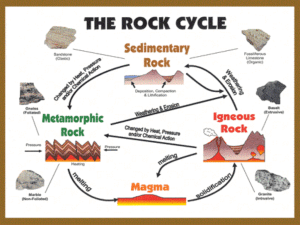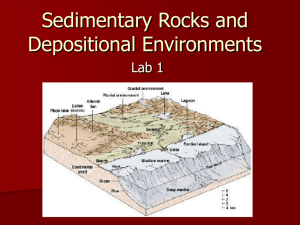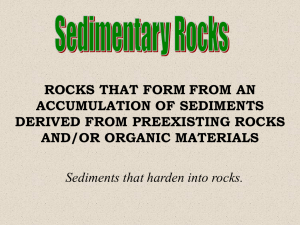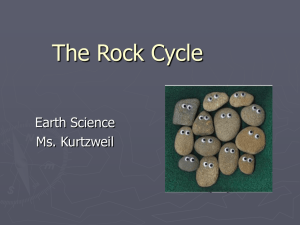Types of Rocks
advertisement
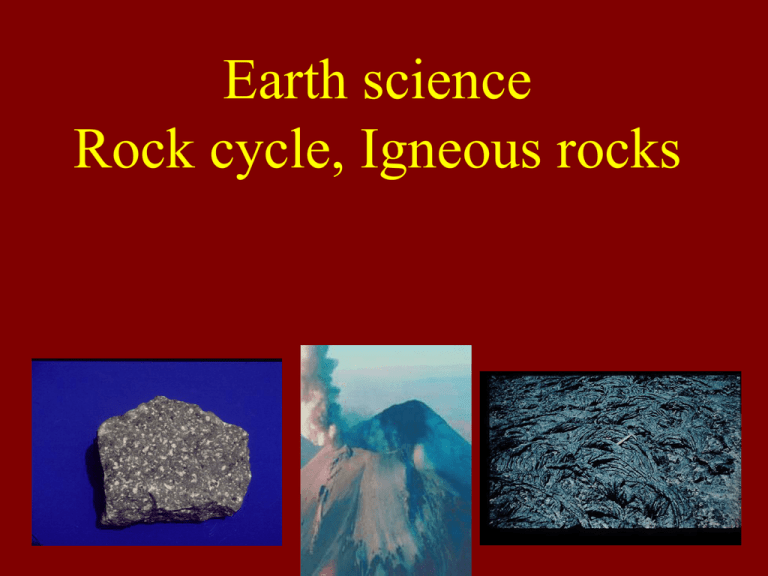
Earth science Rock cycle, Igneous rocks 6.1 The Rock Cycle Rock- a group of minerals bound together in some way • Can consist of one mineral, but usually multiple minerals • Rocks form from other rocks • This relationship is seen in the rock cycle (p 119) Types of Rocks 1. Igneous- formed by the cooling and hardening of magma (hot molten rock) 2. Sedimentary- formed by the compaction and cementation of sediment (rock fragments, plant remains& minerals that have settled out of solution) 3. Metamorphic- formed from the effect of heat and pressure on preexisting rocks 6.2 Igneous Rocks • Categorized by composition, then texture • Texture is caused by cooling environment Magma/ Rocks with Felsic Composition • • • • • • Thick and slow moving magma Cooler (though still very hot) Large amounts of silica Light colored rocks Violent eruptions- builds up pressure Mt. St. Helens (actually closer to intermediate, but close enough) Magma/ Rocks with Mafic Composition • • • • Thinner, faster moving magma Hotter Large amounts of Fe & Mg, little Si Dark colored rocks (ferromagnesian silicates) • Calm eruptions- releases pressure often • Hawaii Textures- Extrusive (aka Volcanic) • Cools above the ground, very quickly • Small crystals, microscopic crystals or no crystallization (not crystalline is not a mineral, has glassy texture- obsidian) • Pumice is created when gas bubbles are “frozen” into quickly cooling rock Obsidian Texture: Intrusive (Plutonic) • Cools below the surface very slowly • Large crystals • Other texture: porphyry- cools below ground, then ejected and cools fast- has large crystals surrounded by small ones Igneous Rock Families • By composition, members have differing textures 1. Granite family- felsic, fine grained is rhyolite, coarse is granite 2. Gabbro family- mafic, fine- basalt, coarse is gabbro 3. Diorite family- intermediate, fineandesite, coarse- diorite 4. Ultramafic Granite & Rhyolite Gabbro & Basalt Diorite & Andesite Ultramafic- Peridotite Plutons (taken from 6.2) • A rock mass that forms when magma cools inside Earth’s interior 1. Batholith 2. Laccolith 3. Stock 4. Sill 5. Dike 6.3 Sedimentary Rocks • 1. 2. 3. 3 main types of sedimentary rocks: Clastic- formed from fragments of other rocks (sediment) Chemical- Form when minerals precipitate (fall out) of solution Organic- Forms from sediments consisting of the remains of plants and animals Clastic Chemical Organic Clastic Sedimentary Rocks • Sediment size (large to small): Boulder, Cobble, Pebbles, Gravel, Sand, Silt, Clay • Eroded and deposited by running water • Larger sizes are first to be deposited, near shore, smaller particles such as sand, silt and clay are deposited further off shore (p 127) • Once sediment is deposited it must be cemented Boulders Pebbles Sand Cementation • Once sediment is deposited it must be cemented • Cementation- the binding of loose sediment by minerals filling the space between grains • Silica (SiO2), Calcite (CaCO3) and Iron oxide/ hematite can act as cements Cement Clastic Sedimentary Rocks 1. 2. 3. 4. Conglomerate- rounded coarse sand and pebbles are cemented together Breccia- similar to conglomerate, but particles are angular Sandstone- sand is cemented Shale- made of clay- often breaks in sheets Conglomerate Breccia Sandstone Shale Chemical Sedimentary Rocks 1. 2. 3. 4. Rock salt- halite Rock gypsum Limestone- can be any color, fine grained, calcite (will fizz in acid) Dolostone- similar to limestone, but made of dolomite (will not fizz in acid) Rock Salt Gypsum Limestone Dolostone Organic Sedimentary Rocks 1. 2. Bituminous coal- plant remains Limestone- formed from the shells of clams, corals and some algae (calcite was taken from chemical limestone) a. chalk b. coquina- made completely of shells Bituminous Coal Organic Limestone Chalk Coquina (limestone) Sedimentary Rock Features 1. Stratification- arrangement of layers of different sediment 2. Bedding plane-plane between layers, usually horizontal, but sometimes cross bedding occurs 3. Fossils- the remains, impression or any other evidence of a plant preserved in rock Stratification Ginko Fossil Sedimentary Rock Features 5. Mud cracks- form when mud dries 6. Nodules- lumps of silica in limestones 7. Concretion- lump of calcite in shale 8. Geodes- hallow lumps of silica in limestone, often have crystals inside Mud Cracks Nodules Concretion Geode 6.4 Metamorphic Rocks Metamorphism- the process by which a rock’s structure is changed by pressure, heat and moisture Metamorphic rocks: • Formed from preexisting rocks called parent rocks • Often resemble their parent Metamorphic Rocks • Minerals may be enlarged, re-formed or new minerals may appear • Pressure forces grains together, making rocks less porous (less space between grains) 2 Types of Metamorphism 1. Regional- occurs during mountain building events • Large areas experience heat and pressure 2. Local- effects much smaller area, 2 subtypes: a. Contact- igneous rock bakes surrounding rock b. Deformation- stress& friction, at faults Rock Descriptions • Identification is often based on parent rock, mineral content and texture • Foliation- the tendency of metamorphic rocks to form bands of minerals or split along parallel layers Metamorphic Rock Types •1. Quartzite- parent rock is sandstone (a sedimentary rock made of sand sized quartz sediment), much more dense than sandstone 2. Marble- parent- limestone (a sedimentary rock made of calcite- fizzes in acid), impurities show as wavy lines, usually fine grained with a sugary texture Metamorphic Rock Types 2 3. Shale series- shale is a sedimentary rock made of clay sized sediment (very small)- all foliated ShaleSlate Phyllite Schist Gneiss Shale Series A. Slate- lowest metamorphismfoliated layers, mineral grains usually cannot be identified B. Phyllite- similar to slate, but is usually shiny due to mica grains becoming larger C. Schist- can also be parented by basalt, mineral grains are usually much larger




